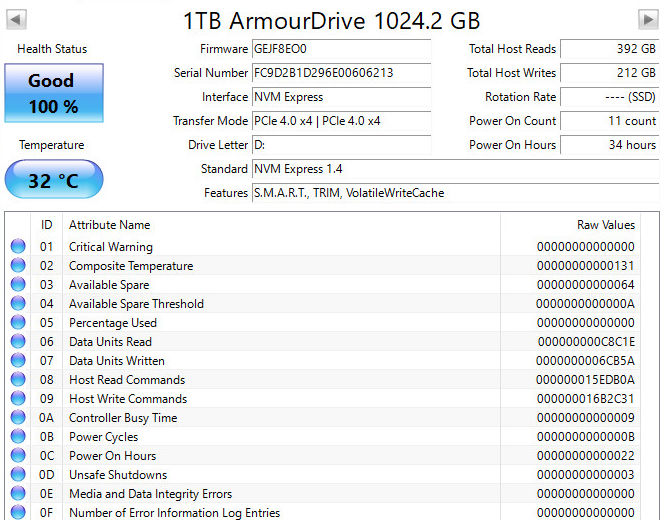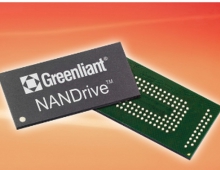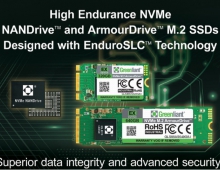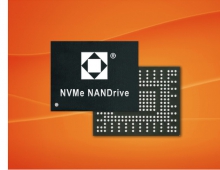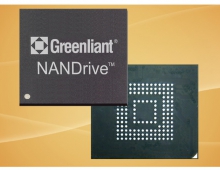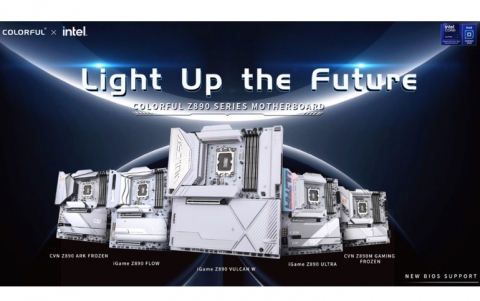Greenliant 1TB M2230 ArmourDrive NVME
1. Introduction
Small-factor NVME drives become very popular among users with the recent release of Valve's SteamDeck, which uses M2230 NVME SSDs. While M2230/M2242 NVME drives have been sold for quite some time at the market, the M2230 market boomed and many vendors keep releasing such products with high capacities.
Greenliant has its solution for this demanding market, called NVMe M.2 ArmourDrive family. It consists of industrial solid-state drives (SSDs) with a high-performance PCIe interface. Supporting the NVMe protocol, the 88 Series provides low latency and fast read/write speeds. To maximize power savings, NVMe M.2 ArmourDrive SSDs support Autonomous Power State Transition (APST) and Active State Power Management (ASPM).
Operating at extreme temperatures, NVMe M.2 ArmourDrive is ideal for high transactional and business-critical applications requiring removable data storage able to withstand demanding environments. The 88 Series implements advanced NAND flash management technology to preserve data integrity and extend SSD lifespan.
The GLS88ET001T3 NVMe M.2 2230 ArmourDrive PX Series is a high-performance, high-reliability solid-state drive that supports up to 1 TByte of NAND flash memory with an advanced NVMe PCIe controller. M.2 ArmourDrive’s advanced NAND management technology improves endurance, enhances data security, and helps prevent data corruption during unexpected power failure events. This innovative technology combines robust NAND controller hardware error correction capabilities with advanced wear-leveling algorithms and bad block management to improve data reliability and significantly extend the life of the product.

The M2230 ArmourDrive series come in three sizes, 256GB/512GB and 1TB
| Capacity | Operating Temperature | Part Number | Form Factor |
| 256GB | Commercial (0°C to 70°C) | GLS88ET256G3-C-BZ306 | 2230 (SS), M key |
| 512GB | GLS88ET512G3-C-BZ306 | ||
| 1TB | GLS88ET001T3-C-BZ306 |
Each M.2 ArmourDrive module integrates an NVMe PCIe SSD controller with up to four NAND flash multi-chip packages. The heart of M.2 ArmourDrive is the NVMe PCIe SSD controller, which translates standard PCIe signals into flash media data and control signals. The following components contribute to M.2 ArmourDrive’s operation. The MCU translates PCIe / NVMe commands into data and control signals required for flash media operation. M.2 ArmourDrive uses internal DMA allowing instant data transfer from/to buffer to/from flash media. This implementation eliminates microcontroller overhead associated with the traditional, firmware-based approach, thereby increasing the data transfer rate. The PMU controls the power consumption of M.2 ArmourDrive. The PMU dramatically reduces the power consumption of M.2 ArmourDrive by putting the part of the circuitry that is not in operation into sleep mode. The Flash File System handles inadvertent power interrupts and has auto-recovery capability to ensure M.2 ArmourDrive firmware integrity.
The embedded flash file system is an integral part of M.2 ArmourDrive. It contains MCU firmware that performs the following tasks:
1. Translates host side signals into flash media writes and reads
2. Provides flash media wear leveling to spread the flash writes across all memory address space to increase the longevity of flash media
3. Keeps track of data file structures
Power Interrupt Data Protection is a mechanism to prevent data corruption during unexpected power failure events. Enhanced data integrity is supported by the controller’s advanced firmware during abnormal power loss. The controller proactively optimizes the amount and stay time of the “in-flight” data residing in the cache. To ensure there is no data loss risk caused by power cycling, the controller sends an acknowledgement to the host only when the incoming data is fully committed to the NAND flash.
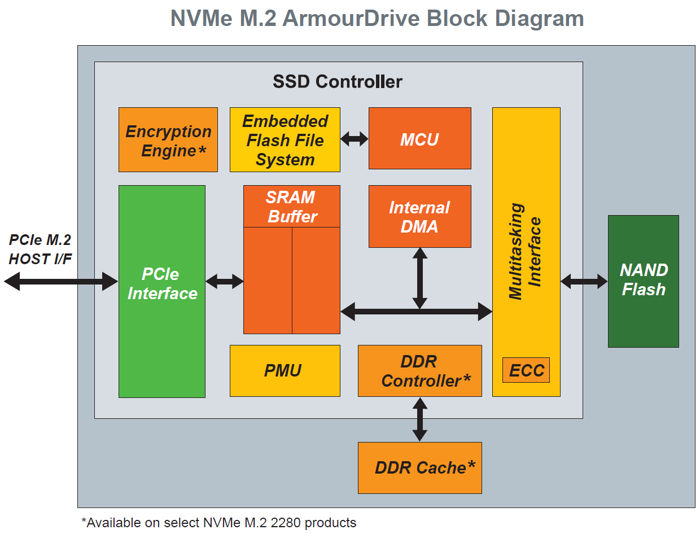
The ECC technology uses advanced LDPC algorithms to detect and correct errors, ensuring data integrity and extending the SSD lifespan. The multi-tasking interface enables concurrent Read, Program and Erase operations to multiple NAND flash media. M.2 ArmourDrive’s controller uses advanced wear-leveling algorithms to substantially increase the longevity of NAND flash media. Wear caused by data writes is evenly distributed in all or select blocks in the device that prevents “hot spots” in locations that are programmed and erased extensively. This effective wear-leveling technique results in optimized device endurance, enhanced data retention and higher reliability required by long-life applications. Advanced data security measures include end-to-end data path protection, data sanitization and Secure Erase support. Secure Erase is an effective method to quickly wipe all data from a PCIe-based SSD using the NVMe protocol (Format NVM).
According to the full specifications, the drive is a PCIe Gen4x4 drive supporting NVMe 1.4 protocol, it supports sequential data read up to 3,600 MB/s / writing up to 2,400 MB/s with 128KB transfer size. The power consumption according to Greenliant measurements reaches < 4,700 mW, while when idling < 40 mW and at the L1.2 mode: < 5 mW. It needs a standard 3.3V single power supply and includes Autonomous power state transition (APST) and Active state power management (ASPM) to reduce PCIe link power consumption. Of course, it supports SMART and TRIM Commands to improve performance, it has 512 Byte / 4 KB Sector Size support and as for reliability, it has a Mean Time Between Failures (MTBF) of 1.5 million hours with up to 600 TeraBytes Written per year. The design is DRAM-less, meaning it uses the Host Memory buffer (HMB) with 128 queues supported. Lastly, it uses 3 bits per cell (3D TLC NAND) with a build-in-house controller.
The 1TB NVME M2230 drive variant costs around 190 Euro at Mouser: https://www.mouser.com/c/?q=gls88et and for our USA friends somewhat lower at $169 at Future Electronics: https://www.futureelectronics.com/search/?text=gls88et
- Installation
Not much to be said here, just get the drive and plug-it into an empty NVMe slot. In some boards you have to change Bios settings to Storage: PCIe to get the drive recognized. We used the stock Microsoft NVME driver with the NTFS file system for all tested drives. The test PC system was based on AMD format, with a Ryzen 5 5600X, 32GB DDR4 RAM (G.Skill CL14), and an Asus ROG Strix X570-E Gaming Motherboard with the latest 4601 bios and AMD motherboard drivers/Windows 10 x64 drivers installed. No antivirus was running in the background.
After the initial format, you should expect to see around 931MB of free space for the 1TB variant. The CrystalDiskInfo software gives us some details about the 1TB model, it runs at PCIe 4.0 x4 and supports NVM Express 1.4 protocol with the Asus X570-E Gaming motherboard:
